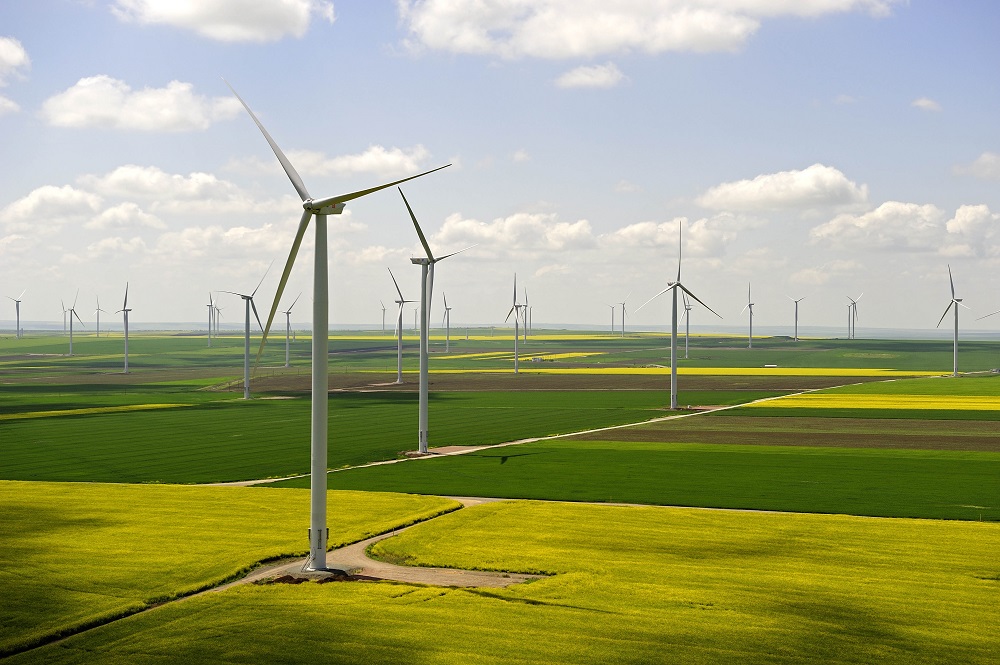Strong, steady winds blow across the Oklahoma Panhandle, including a portion of the Black Mesa, a 28-mile grassy scrap left over from ancient lava flow — and the highest point in the state at nearly 5,000 feet. Once known as “No Man’s Land,” the Panhandle is part of North America’s corridor of wind farms running roughly from Minnesota to Texas. Soon, it will be home to the largest wind farm in the United States.
GE Renewable Energy and Invenergy announced they are building the Wind Catcher, a 2,000-megawatt wind farm in the Oklahoma Panhandle that will be completed in mid-2020. GE will supply 800 turbines, each producing 2.5 megawatts of energy.
A typical wind farm in the United States might have 50 to 100 turbines, says Andy Holt, general manager of North America Wind for GE Renewable Energy. “To have 800 turbines is a really big deal for the industry,” he said.

The GE turbines will be equipped with sensors that will allow each turbine to measure its performance and compare its own production to that of nearby turbines. In addition, the entire wind farm will be able to monitor how much energy it is producing, with respect to the wind conditions at the time. The system will be powered by Predix, GE’s platform for the Industrial Internet, for big data analysis and for monitoring.
If any part of the system is underperforming, technicians will be alerted. “These are digital wind turbines, aware of themselves and their neighbors and the entire farm,” Holt said. “That’s revolutionary right there.”
The Oklahoma wind facility will be part of the $4.5 billion Wind Catcher Energy Connection, which will include a proposed 350-mile, extra-high-voltage power line constructed by American Electric Power (AEP). The facility and power line will deliver renewable energy to more than 1.1 million customers in Louisiana, Arkansas, Texas and Oklahoma.
AEP is seeking approval from regulators in those four states to move the project to its next stage.
The project is expected to save AEP customers more than $7 billion over 25 years. Construction of the wind facility and power line will create 4,500 direct jobs and support another 4,500 indirect jobs. When the facility is online, it will support 80 full-time jobs. The project also will generate more than $500 million in local economic benefits such as property taxes and lease payments to landowners.
The new wind farm also will address an ongoing challenge in renewable-energy development: Land for projects such as onshore wind farms tends to be cheap in areas where few people live, reducing the efficiency of delivering the energy. The power line will help move wind energy from inexpensive Oklahoma land to customers in states where it could be too costly to site a wind farm.
GE plans to manufacture a portion of the major components of the machines in Oklahoma, Arkansas, Texas and Louisiana.
The giant new wind farm is part of a broader push toward renewable energy in the United States. The nation’s renewable-energy capacity more than tripled from 2008 to the end of 2016, reaching 141 gigawatts (a gigawatt is 1,000 megawatts). Wind and solar power largely drove this growth.
Oklahoma has been at the forefront of this trend. It recently passed California to become the No. 3 state in wind-energy capacity, behind Texas and Iowa, with 6,645 megawatts of installed capacity in 2016.
Today, wind energy contributes 25 percent of power in Oklahoma, enough to power 1.8 million homes, and employs more than 8,000 people. Wind-energy production in Oklahoma saves more than 4 million gallons of water a year compared with coal and gas plants, and last year it avoided 8.3 million metric tons of carbon-dioxide emissions that contribute to climate change.
Still, the U.S. lags the European Union and China in wind-energy capacity, although the Wind Catcher facility in Oklahoma could help the U.S. begin to catch up. When completed, the Wind Catcher facility will be the second largest in the world behind the Jiuquan Wind Power Base, also known as the Gansu Wind Farm, a project located in China that is slated for completion in 2020.
Holt said: “Super-projects like this one are milestones for just how much wind will be developed and how many families will be impacted and jobs will be created.”

